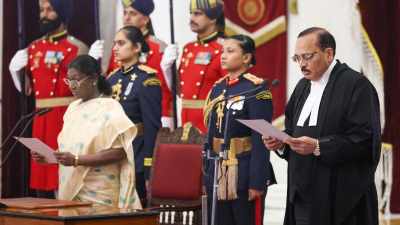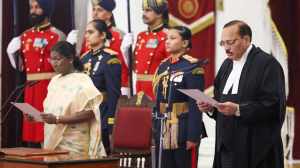The Singing Sufi
To mark the birth centenary of Hindustani vocalist Bade Ghulam Ali Khan, his Delhi-based pupil Malti Gilani has written a biography of her t...

To mark the birth centenary of Hindustani vocalist Bade Ghulam Ali Khan, his Delhi-based pupil Malti Gilani has written a biography of her teacher in collaboration with Urdu writer Quratulain Hyder. Its publication, by Harman, New Delhi, is sponsored by the Department of Culture, Government of India, and the heavy, illustrated volume is priced at a Khan-sized Rs 1200. The copyright vests with Khan Sahib’s descendants.
Despite one’s eagerness to admire everything about the book because of one’s love for the subject, several points do strike the reader. Firstly, it seems to be entirely Malti Gilani’s narrative. She is the only “I” in the book and it is M.F. Husain’s striking painting of Khan Sahib and her that adorns the cover. In her introduction, she goes on everlastingly about her own family of Punjabi doctors and academicians, including the names of each of her siblings. A bit self-indulgent on taxpayers’ money, wouldn’t you say?
Secondly the book is not particularly well written, edited or proofed. The authors break out frequently into great swoops of 1950s Indian (convent) English, drenched heavily in cliche: “The family of Ghulam Ali Khan, belonged to this tradition and it was their pride and joy to be a part of it.” Or, talking of his romance with Lahori courtesan Gulzar Bai, the authors say, “It was an idyllic existence and a storybook romance in which the composer, the singer and the song had all become one. It was a kind of reflection of the cosmic melody, until one day, the proverbial serpent appeared in the Garden of Eden!”
Gushy mamas, you think, but you know what? It’s rather sweet, even the utterly-predictable-for-the-era bit from Tennyson’s “Crossing the bar” as epigraph for the chapter on Khan Sahib’s passing. It recalls the Teenmurti Template for smart urban Indians who were lucky enough to be young in the 1950s, in the Nehruvian afterglow of Independence. Taking their cue from Panditji, Vijayalakshmi Pandit and Indira Gandhi, young women of that time followed a New India cultural checklist on dress, decoration, accomplishments and even marriage — a madly eclectic mix of tradition and modernity, East and West.
It is this openness and idealism that informs the tone of the narrative and leaves the battered New Millennium Indian profoundly touched and sorrowful at how good India could have been — it began so well! So, despite Gilani’s amusing “Almanach de Gotha” of didi-chachi-bua-maasi, to mock the authors seems perilously like mocking our own “elitist” mothers, the generation that played college and club tennis in salwar-kameez, collected candlewick bedspreads, arranged calendulae in green glasses and put tussar lampshades on Chianti and Contessa Rum bottles.
How does this pop sociology relate to Bade Ghulam Ali Khan, a Sufi of Kasur (now in Pakistan) born to the first wife of a court musician and raised by a tawaif because his father was too afraid of his second wife to keep Ghulam Ali with him? Very directly! But for this “educated elite” of New India, that whole great generation of ustads and musicians would have sunk without a trace. New India’s efforts to learn classical music (and dance), destroy the old barriers between artistes and “society”, hold baithaks, get corporate sponsorship, make recordings, note down compositions, were important building blocks of our renaissance, along with the elegant new saris they wore courtesy Kamladevi Chattopadhyay’s efforts in the handloom revival.
Thus the authors notice Khan Sahib’s crisp new kurtas, the kajal in his eyes, the henna he coloured his hair with two days before Eid, the food he loved. And especially, all the people who loved him, from Kolkata’s connoisseurs and Hyderabadi nawabs to singer Noorjehan, from the sternest Carnatic vidwans of Madras to Raj Kapoor, K.A. Asif (who made him sing for Mughal-e-Azam) and the King of Afghanistan. This is therefore valuable documentation of a lovely piece of India’s past (Khan Sahib’s compositions about adha, Ram and Sudama are unimaginable today). The transcripts of his songs are a wonderful appendix and especially, the poems and proverbs frequently quoted, give texture to this story of a life well-lived.






- 01
- 02
- 03
- 04
- 05

























